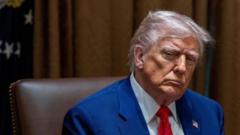In recent developments, Donald Trump’s ambitious tariff strategy, initially aimed at drastically altering global trade dynamics, has faced a setback. The President has temporarily put a hold on increases in tariffs, particularly with allies, while simultaneously pursuing a confrontational approach with China. As the implications of this pause unfold, we evaluate five pivotal tariff ambitions Trump laid out and their current standings.
1) **Better Trade Deals**
* **What Trump Said:** Decades of trade practices have unfairly benefitted other nations at the expense of the U.S.
* The administration made waves with a sweeping tariff proposal, introducing a 10% baseline tariff across various imports, prompting global leaders to engage in negotiations. Treasury Secretary Scott Bessent reported that over 75 leaders have reached out to discuss trade agreements, signaling potential for concessions. However, with a 90-day window for negotiations, time is critical.
2) **Boosting American Industry**
* **What Trump Said:** The U.S. will witness a resurgence in jobs and manufacturing.
* While tariffs are seen as a mechanism to shield American industries, the volatility of Trump’s recent tariff changes creates uncertainty. This unpredictable policy environment may deter domestic companies from committing to investments in production and reshoring.
3) **Facing Off with China**
* **What Trump Said:** The nation has long exploited U.S. trade policies for its benefit.
* Trump sees China as the primary adversary in global trade disputes. However, balancing a conflict with a major global economy brings significant risks and could jeopardize relationships with U.S. allies necessary in such a scenario.
4) **Raising Revenue**
* **What Trump Said:** Tariffs will yield significant revenue for the government.
* In past statements, Trump underscored the potential financial windfall from tariffs against imports, reinforcing his budgetary goals. Studies suggest a 10% universal tariff could generate substantial revenue over the next decade. The question remains whether these gains will be realized or diminish as domestic production ramps up.
5) **Lower Prices for U.S. Consumers**
* **What Trump Said:** Increased domestic production will lead to competitive pricing for consumers.
* Despite aspirations of lower consumer prices, experts warn that tariffs will likely increase costs for American households, negating Trump's promise of economic relief. The Tax Foundation estimates that a universal 10% tariff could not only hike prices but disproportionately affect lower-income families.
As Trump’s tariff saga continues, the volatile interplay of domestic policies and international trade dynamics presents a complex landscape. Balancing ambitious goals with practical outcomes remains essential for understanding the future of U.S. economic policies in a global context.



















